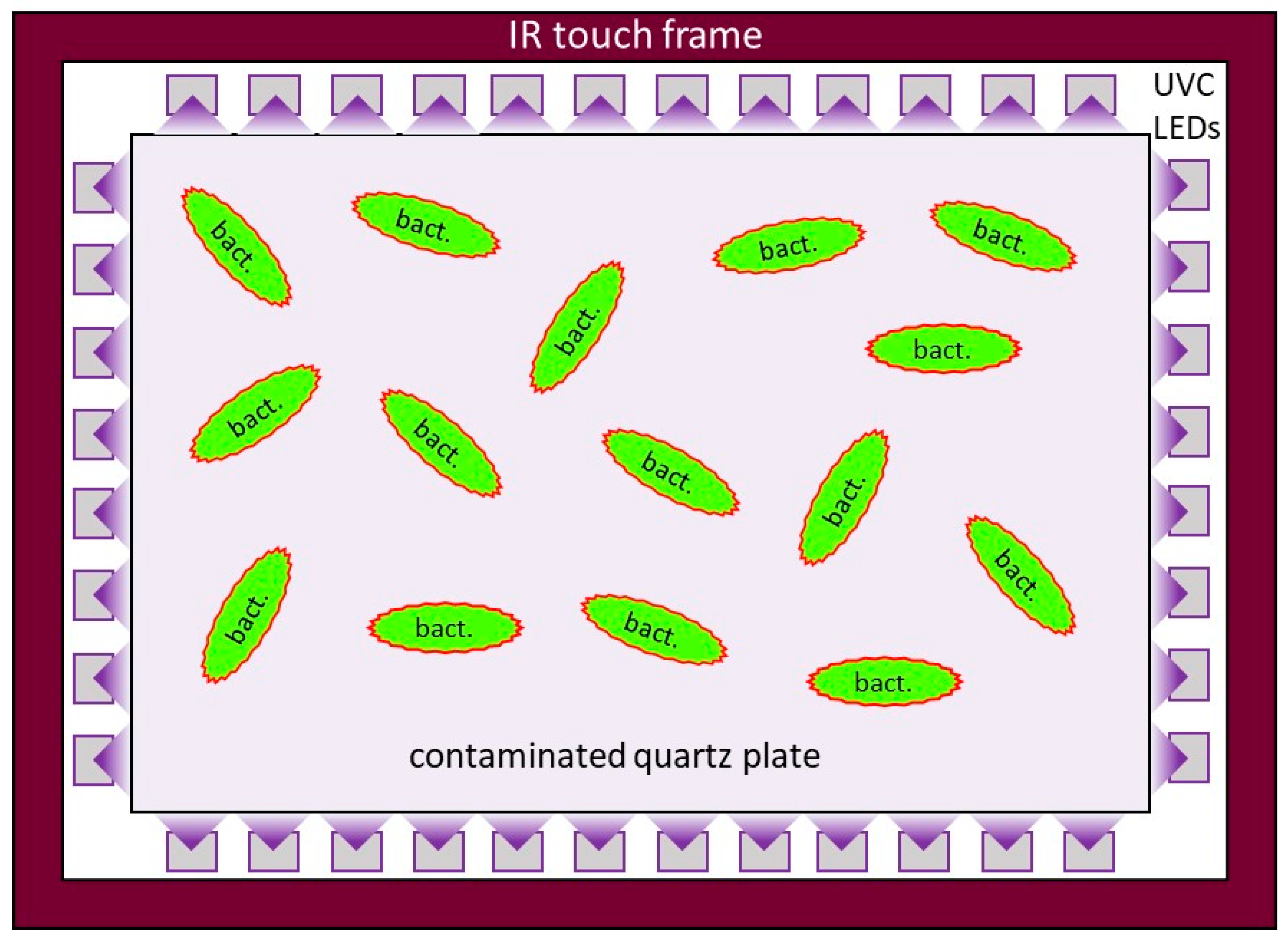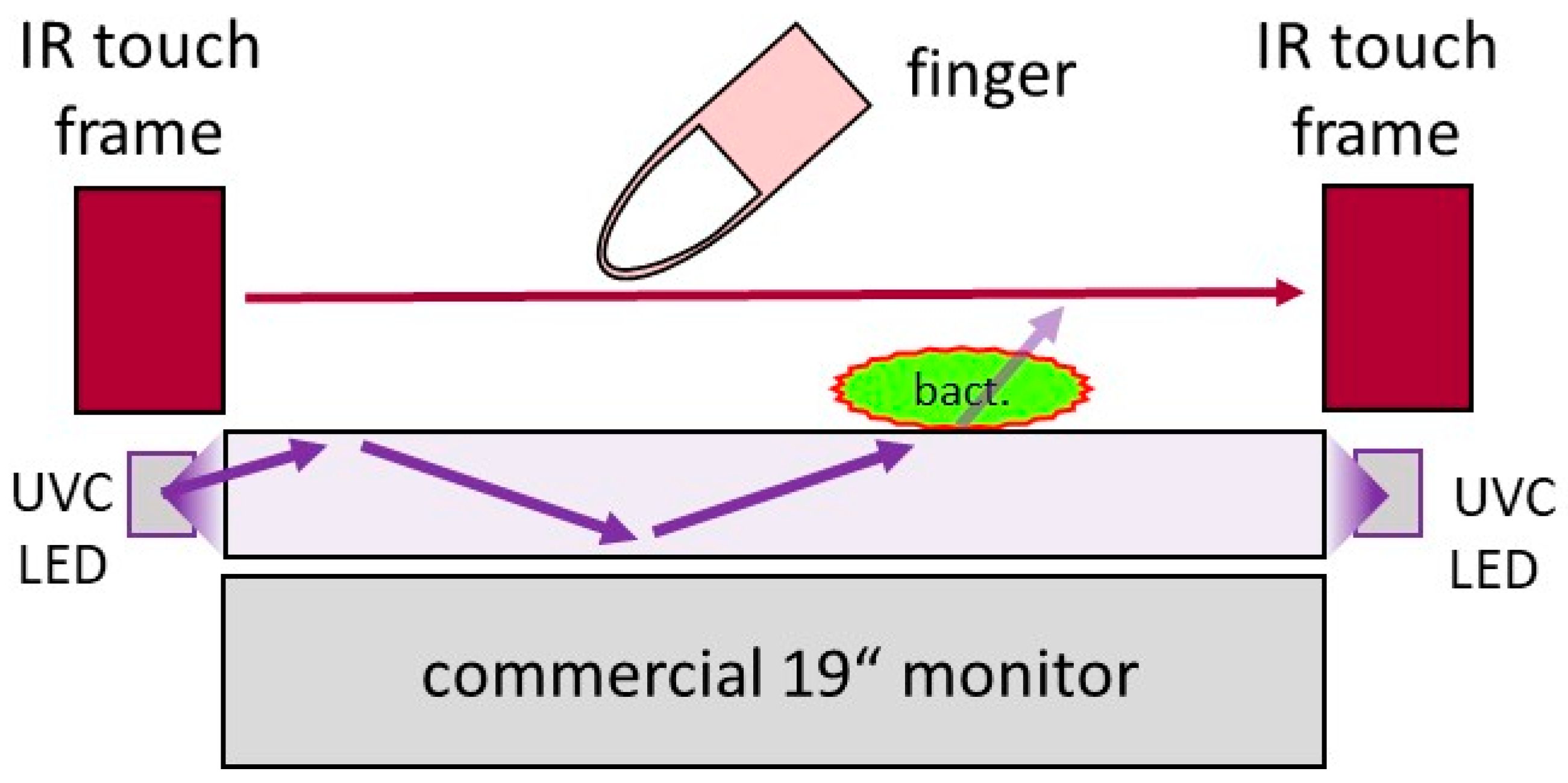Prototype of a Public Computer System with Fast Automatic Touchscreen Disinfection by Integrated UVC LEDs and Total Reflection †
Abstract
1. Introduction
2. Materials and Methods
2.1. Hard- and Software
2.2. Microbiology and Data Analysis
3. Results
3.1. Hard- and Software
3.2. Microbiology and Data Analysis
4. Discussion
5. Study Limitations
Author Contributions
Funding
Institutional Review Board Statement
Informed Consent Statement
Data Availability Statement
Conflicts of Interest
References
- Business Research Insights. OGS Touch Screen Market Size, Share, Growth, and Industry Growth by Type (Double Point Touch and Multi-Point Touch) by Application (Tablets, Mobile Phones, Medical Equipment, and Vehicle Electronics), Regional Insights, and Forecast to 2031; Maharashtra, India, 2024. Available online: https://www.businessresearchinsights.com/market-reports/ogs-touch-screen-market-100059 (accessed on 3 May 2024).
- Emergen Research. Multi-Touch Screen Market, by Technology (Resistive, Capacitive, Optical, and Others), by Product (Smartphone, Tablets, Laptops, and Others), by End-Use (Consumer Electronics, Education, and Others), and by Region Forecast to 2032; Surrey, British Columbia, 2023. Available online: https://www.emergenresearch.com/industry-report/multi-touch-screen-market (accessed on 3 May 2024).
- Technavio. Touch Screen Market Analysis APAC, North America, Europe, South America, Middle East and Africa—US, China, Japan, India, Germany—Size and Forecast 2024–2028; Toronto, Canada, 2024. Available online: https://www.technavio.com/report/touch-screen-market-industry-analysis (accessed on 3 May 2024).
- Hessling, M.; Haag, R.; Sicks, B. Review of microbial touchscreen contamination for the determination of reasonable ultraviolet disinfection doses. GMS Hyg. Infect. Control 2021, 16, Doc30. [Google Scholar] [CrossRef] [PubMed]
- Kowalski, W. Introduction. In Ultraviolet Germicidal Irradiation Handbook; Kowalski, W., Ed.; Springer: Berlin/Heidelberg, Germany, 2009; pp. 1–16. ISBN 978-3-642-01998-2. [Google Scholar]
- Haji Malayeri, A.; Mohseni, M.; Cairns, B.; Bolton, J.R. Fluence (UV Dose) Required to Achieve Incremental Log Inactivation of Bacteria, Protozoa, Viruses and Algae. IUVA News 2016, 2016, 1–41. [Google Scholar]
- Tomb, R.M.; White, T.A.; Coia, J.E.; Anderson, J.G.; MacGregor, S.J.; Maclean, M. Review of the Comparative Susceptibility of Microbial Species to Photoinactivation Using 380-480 nm Violet-Blue Light. Photochem. Photobiol. 2018, 94, 445–458. [Google Scholar] [CrossRef] [PubMed]
- Hessling, M.; Spellerberg, B.; Hoenes, K. Photoinactivation of bacteria by endogenous photosensitizers and exposure to visible light of different wavelengths—A review on existing data. FEMS Microbiol. Lett. 2016, 364, fnw270. [Google Scholar] [CrossRef] [PubMed]
- Hessling, M.; Spellerberg, B.; Hönes, K. Potential self-disinfection capacity of touch screen displays. J. Biophotonics 2019, 12, e201900118. [Google Scholar] [CrossRef] [PubMed]
- Sicks, B.; Gierke, A.-M.; Sommerfeld, F.; Klein, M.; Hessling, M. Disinfection of Transparent Screens by Side-Coupled UVA LED Radiation. Optics 2023, 4, 321–329. [Google Scholar] [CrossRef]
- Sicks, B.; Gurow, O.; Hessling, M. Future Disinfection of Touch Screens by Far-UVC-LEDs?—A Feasibility Study. IEEE Photon. Technol. Lett. 2024, 36, 981–984. [Google Scholar] [CrossRef]
- Gierke, A.-M.; Hessling, M. Investigation on Potential ESKAPE Surrogates for 222 and 254 nm Irradiation Experiments. Front. Microbiol. 2022, 13, 942708. [Google Scholar] [CrossRef] [PubMed]
- Directive 2006/25/EC of the European Parliament and of the Council on the Minimum Health and Safety Requirements Regarding the Exposure of Workers to Risks Arising from Physical Agents (Artificial Optical Radiation). Off. J. Eur. Union 2006, 114, 38–59.
- American Conference of Governmental Industrial Hygienists. 2022 Threshold Limit Values (TLVs) and Biological Exposure Indices (BEIs); ACGIH: Cincinnati, OH, USA, 2022; ISBN 978-1-607261-52-0. Available online: https://www.techstreet.com/standards/2022-threshold-limit-values-tlvs-and-biological-exposure-indices-beis?product_id=2242171#jumps (accessed on 3 May 2024).
- Pratzer, A. Python-Lernen; Tübingen, 2021. Available online: https://www.python-lernen.de/ (accessed on 3 May 2024).
- Deutsche Sammlung von Mikroorganismen und Zellkulturen. M92: Trypticase Soy Yeast Extract Medium. Available online: https://www.dsmz.de/microorganisms/medium/pdf/DSMZ_Medium92.pdf (accessed on 5 April 2023).
- Sicks, B.; Gurow, O.; Sommerfeld, F.; Hessling, M. Decontamination of Fused-Silica Surfaces by UVC Irradiation as Potential Application on Touchscreens. Microorganisms 2024, 12, 2099. [Google Scholar] [CrossRef] [PubMed]




Disclaimer/Publisher’s Note: The statements, opinions and data contained in all publications are solely those of the individual author(s) and contributor(s) and not of MDPI and/or the editor(s). MDPI and/or the editor(s) disclaim responsibility for any injury to people or property resulting from any ideas, methods, instructions or products referred to in the content. |
© 2024 by the authors. Licensee MDPI, Basel, Switzerland. This article is an open access article distributed under the terms and conditions of the Creative Commons Attribution (CC BY) license (https://creativecommons.org/licenses/by/4.0/).
Share and Cite
Deuschl, S.; Sicks, B.; Moritz, H.; Hessling, M. Prototype of a Public Computer System with Fast Automatic Touchscreen Disinfection by Integrated UVC LEDs and Total Reflection. Phys. Sci. Forum 2024, 10, 3. https://doi.org/10.3390/psf2024010003
Deuschl S, Sicks B, Moritz H, Hessling M. Prototype of a Public Computer System with Fast Automatic Touchscreen Disinfection by Integrated UVC LEDs and Total Reflection. Physical Sciences Forum. 2024; 10(1):3. https://doi.org/10.3390/psf2024010003
Chicago/Turabian StyleDeuschl, Sebastian, Ben Sicks, Helge Moritz, and Martin Hessling. 2024. "Prototype of a Public Computer System with Fast Automatic Touchscreen Disinfection by Integrated UVC LEDs and Total Reflection" Physical Sciences Forum 10, no. 1: 3. https://doi.org/10.3390/psf2024010003
APA StyleDeuschl, S., Sicks, B., Moritz, H., & Hessling, M. (2024). Prototype of a Public Computer System with Fast Automatic Touchscreen Disinfection by Integrated UVC LEDs and Total Reflection. Physical Sciences Forum, 10(1), 3. https://doi.org/10.3390/psf2024010003




